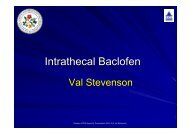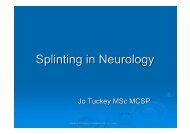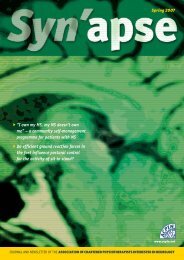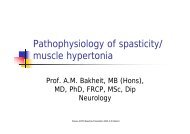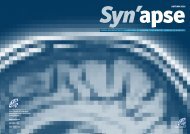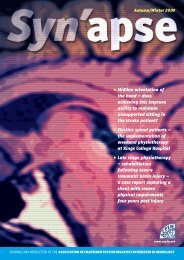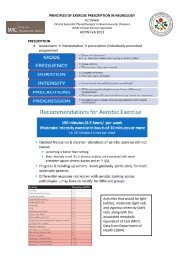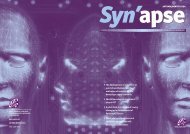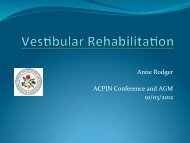Spasticity Management: Long term follow up- a team ... - acpin
Spasticity Management: Long term follow up- a team ... - acpin
Spasticity Management: Long term follow up- a team ... - acpin
Create successful ePaper yourself
Turn your PDF publications into a flip-book with our unique Google optimized e-Paper software.
<strong>Spasticity</strong> <strong>Management</strong>:<strong>Long</strong> <strong>term</strong> <strong>follow</strong> <strong>up</strong>- a <strong>team</strong>approachLiz KeenanClinical nurse specialist in <strong>Spasticity</strong> <strong>Management</strong>,NHNNWessex ACPIN <strong>Spasticity</strong> Presentation 2009. © Liz Keenan
Optimal managementApproach needs to be:MultidisciplinaryHolisticCoordinated– Clinical governance, Protocol, Telephone help lineTailored to the individualTimelyWessex ACPIN <strong>Spasticity</strong> Presentation 2009. © Liz Keenan
<strong>Long</strong> <strong>term</strong> <strong>follow</strong> <strong>up</strong> forIntrathecal Baclofen (ITB)Pump battery life is between 5-757 yearsBaclofen stability 180 daysRoutine refill every 6/12Post implants more frequent visits as doseis being ‘fine tuned’Wessex ACPIN <strong>Spasticity</strong> Presentation 2009. © Liz Keenan
Holistic review every 6 monthsAssessment– General health– Trigger/ aggravating factorsEfficacy– Goal attainment, outcome measures, joint therapyreviewRefill procedureSpecial circumstances– Changing dose, concentration, MRI, Dye tests– Trouble shootingWessex ACPIN <strong>Spasticity</strong> Presentation 2009. © Liz Keenan
General reviewAny new problems– With underlying condition– With spasticity, pain, spasms– With treatment (side effects, reduced efficacy)Review current anti-spasticity treatmentWeight, dentitionTrigger factorsWessex ACPIN <strong>Spasticity</strong> Presentation 2009. © Liz Keenan
Triggers and noxious stimuliSkinSplintsOrthoticsBladderBowelsPain, skinWessex ACPIN <strong>Spasticity</strong> Presentation 2009. © Liz KeenanSeating & positioning
Assessment-Hands OnObserve- posture, movement andalignmentObserving - GaitFeel resistance to passivemovementDe<strong>term</strong>ine biomechanicalcomponentAssess underlying weaknessWessex ACPIN <strong>Spasticity</strong> Presentation 2009. © Liz Keenan
MeasuresReview goal attainmentTone - AshworthRange of movement – GoniometryTimed functional tasks, 10m walkDisease specific scales eg. MSSS-88Carer ratings for ease of careWessex ACPIN <strong>Spasticity</strong> Presentation 2009. © Liz Keenan
MeasuresSpasm scale - (Pennet al 1989)Visual analogues ofpain, comfort, legstiffnessConsider therapyreview at leastannuallyWessex ACPIN <strong>Spasticity</strong> Presentation 2009. © Liz Keenan
In Practice24yr man with CP, receiving ITB for 6 years,independently mobile however had reportedfalling over the last few months– Moved to UK from USA– Dose had been changed for years– Booked to have assessment with PT– All measures completed– Recommendation to reduce dose 10%Wessex ACPIN <strong>Spasticity</strong> Presentation 2009. © Liz Keenan
Physical management of spasticityCONSIDERStandingActiveexerciseBalancebetweenmovementandpositioningFunctionalelectricalstimulationWheelchairpostureand seatingPassivemovementStretchesSplintingand theuse oforthoticsWessex ACPIN <strong>Spasticity</strong> Presentation 2009. © Liz Keenan
In Practice65yr man with MS, receiving ITB for 15 years– His wife called help line reporting increase in spasms,but only at night– Booked to have joint assessment PT / CNS– Ax in lying and seating and all measures completed– RecommendationAdvice given on physical management strategies– Side lying– Using profile element of bed– Seating alignment– Bladder and skin careWessex ACPIN <strong>Spasticity</strong> Presentation 2009. © Liz Keenan
In practice:community physiotherapistLinking with community <strong>team</strong>TIMEPerson with spasticity and their PT assessingfunction in home environmentFeed back to spasticity <strong>team</strong> (eg ITB)Wessex ACPIN <strong>Spasticity</strong> Presentation 2009. © Liz Keenan
ITB Refill clinicExamine pump site examine skin andobserve for any signs of infection (brokenskin, tenderness and redness)Wessex ACPIN <strong>Spasticity</strong> Presentation 2009. © Liz Keenan
TelemetryRead pumpCheck;– Patient data– Baclofen concentration– Dose– Dosing schedule– Reservoir volume– Volume drug remaining– Alarms enabledWessex ACPIN <strong>Spasticity</strong> Presentation 2009. © Liz Keenan
Data storedCritical therapy data stored in pump for<strong>follow</strong> <strong>up</strong> at any recognised centre– Patient demographics– Pump implant information– Catheter : type, length / volume– Implant/Revision HistoryNotesWessex ACPIN <strong>Spasticity</strong> Presentation 2009. © Liz Keenan
Position for refillNo special requirementsTilt in space slightly tilted back for ease ofaccess.LyingWessex ACPIN <strong>Spasticity</strong> Presentation 2009. © Liz Keenan
Refill kit equipmentWessex ACPIN <strong>Spasticity</strong> Presentation 2009. © Liz Keenan
Refill procedureAsceptic techniqueRefill kitLocate central reservoir portNot catheter access portEmpty pump and checkvolume removed appropriateRefill pump with appropriateconcentration and volumeWessex ACPIN <strong>Spasticity</strong> Presentation 2009. © Liz Keenan
Refill procedureWessex ACPIN <strong>Spasticity</strong> Presentation 2009. © Liz Keenan
ReprogrammingChange reservoir volumeMake any dose or dosagescheduling changesCheck with 2 people;– Patient data– Baclofen concentration– Dose– Dosing schedule– Reservoir volume– Alarms enabled– Low reservoir alarm datePrint copies for notes andpatient held recordsWessex ACPIN <strong>Spasticity</strong> Presentation 2009. © Liz Keenan
Principles of titrationChange one thing at a timeDo not change oral until getting a responsefrom ITBIncrease (10% - 20%)Review spasticity in context of:Function at home and workAgreed GoalPrevious measuresOral medicationNo magic titration formulaWessex ACPIN <strong>Spasticity</strong> Presentation 2009. © Liz Keenan
Infusion ModesvolumetimeSimple continuousvolumetimeSingle bolus +Simple continuousvolumetime“Flex” modevolumeWessex ACPIN <strong>Spasticity</strong> Presentation 2009. © Liz KeenantimeMinimum rate
Careful considerationChanging the Baclofen concentrationComplications with the pump and catheterDye studyMRIWessex ACPIN <strong>Spasticity</strong> Presentation 2009. © Liz Keenan
Changing Baclofen concentrationCaution is needed to prevent accidental overdosePerform telemetryEmpty the pump completely checking the expectedreservoir volumeRinse the reservoir twice with normal salineFill the pump with the new concentration solution– Usually 500-3000mcg/mlReprogramme the pump with the new parameters(reservoir volume, concentration and any change in dose)Perform a bridging bolusCheck all parameters with a colleagueWessex ACPIN <strong>Spasticity</strong> Presentation 2009. © Liz Keenan
Change of concentrationInternal PumpTubingCatheterDRUGPumpReservoirA Bridge bolus needto be completedWessex ACPIN <strong>Spasticity</strong> Presentation 2009. © Liz Keenan
Catheter-Related ComplicationsKinking, disconnectionMicro-tearComplete or partial occlusionDislodgement or migrationFibrosisDetached catheter tip or catheter fragment(s) inthe intrathecal spaceWessex ACPIN <strong>Spasticity</strong> Presentation 2009. © Liz Keenan
SynchroMed II PumpMechanicsWessex ACPIN <strong>Spasticity</strong> Presentation 2009. © Liz Keenan
Pump RefillWessex ACPIN <strong>Spasticity</strong> Presentation 2009. © Liz Keenan
Dye StudiesCaution is needed to prevent accidental overdosePerform telemetry and stop pumpAsceptic technique in RadiologyUse catheter port access kit and locate catheter portAspirate at least 2mlsIf unable to aspirate stop procedure- do not attempt to flushInject radiopaque dye and perform fluroscopyIf resuming ITB restart pump and perform a catheterpriming bolus (catheter volume only, not internal tubing)Check all parameters with a colleagueWessex ACPIN <strong>Spasticity</strong> Presentation 2009. © Liz Keenan
Post dye studyInternal PumpTubingDRUGCatheterPumpReservoirDRUGIf resuming ITB restart pumpand perform a catheter primingbolus (catheter volume only,not internal tubing)Check all parameters with acolleagueWessex ACPIN <strong>Spasticity</strong> Presentation 2009. © Liz Keenan
MRICheck with senior radiologist and pump manufacturerScanning time may be increased due to metallic pump andartefact possibleAll rotar arm motorised pumps (Medtronic) will suspend drugdelivery during scanAlways perform telemetry 30 mins after imagingFollow manufacturer’s s instructions to ensure pump log showsmotor stall and recoveryCheck all parameters with a colleagueWessex ACPIN <strong>Spasticity</strong> Presentation 2009. © Liz Keenan
Help lineTelephone help lineContinuity of care and access whennecessaryOut of hours link to a NeurorehabilationUnit which takes call, completing atemplate so accurate information isgatheredWessex ACPIN <strong>Spasticity</strong> Presentation 2009. © Liz Keenan
Ongoing management<strong>Management</strong> continues every 6 monthsTitration continues with 10%-20% intervals of increaseContinue to have regular phone contactRecent discussion with patient she expressed that shewas very happy that her spasms and spasticity had gonebut it has made her ‘face‘ her disability which wascompounded by a longstanding low mood, however“having more comfort, less pain and spasms I get abetter nights sleep, so I feels more prepared to makechanges in my life”.Wessex ACPIN <strong>Spasticity</strong> Presentation 2009. © Liz Keenan
ReferencesDarzi Report (2008) High Quality Care For All: NSR final reportlaunched. National Health Service, Department of Health.LondonDepartment of Health (2005) National Service Framework for<strong>Long</strong>-Term Conditions. The Stationery Office, LondonJarrett L (2006) The nurse's role in assessing and measuringspasticity. Nursing Times; 102: 26-8Penn RD, Savoy SM, Corcos D et al. (1988) Intrathecal baclofenfor severe spinal spasticity. N Engl J Med;320:1517–21.21.Stevenson V, Jarrett L (2006) <strong>Spasticity</strong> <strong>Management</strong>: APractical Multidisciplinary Guide. Informa Health Care, OxfordThompson AJ, Jarrett L, Lockley L, Marsden, J and StevensonV (2005) Clinical management of spasticity. Journal of J NeurolNeurosurg Psychiatry; 76: 459-463463Welmer A-K, Avon Arbin M, Widen Holmqvist L, SommerfeldDK ( 2006) <strong>Spasticity</strong> and its association with functioning andhealth –related quality of life 18 months after stroke.Wessex ACPIN <strong>Spasticity</strong> Presentation 2009. © Liz KeenanCerebrovascular Disease; 21:247-253253




